Corn Bunting
Least ConcernEmberiza calandra
Visual Identification
Appearance
The Corn Bunting is a plump, sparrow-sized bird with overall brown plumage streaked with darker markings. It has a large, robust bill, a short tail, and a distinctive 'heavy-headed' appearance. The underparts are pale buff with fine streaking.
Both males and females look similar. Juveniles closely resemble adults but may have slightly fresher-looking feathers with more defined streaking.
Size
Length
16cm to 19cm
Wingspan
26cm to 32cm
Weight
38g to 55g
Colours
Males and females have similar plumage
Primary Colour
Brown
Secondary Colour
Buff White
Beak Colour
Grey Orange
Leg Colour
Pink
Habitat and Distribution
Habitats
Woodland
Garden
Wetland
Coastal
Urban
Farmland
Grassland
Desert
Tundra
Rainforest
Mountain
Savanna
Distribution
Corn Buntings inhabit open agricultural landscapes, preferring cereal fields, grasslands, and areas with scattered bushes or hedgerows. They are found across much of Europe and extend into western Asia and North Africa.
In the UK, they are mainly concentrated in eastern and southern England, with some populations in Scotland. Their distribution can vary seasonally, with some birds moving to lowland areas in winter.
Elevation Range
Up to 500 meters
Climate zones
Temperate, Mediterranean
Distribution Map
This map gives you a rough idea of where you might spot a Corn Bunting. The coloured areas show countries where these birds have been seen.
A few things to keep in mind:
- Birds might not be everywhere in the coloured areas, for example, they may be present around the coast of that country
- Where birds live can change with seasons and available food
- This map is quite simple - it doesn't show exact locations
We're working on making our maps even better! Soon, we hope to show you:
- More detailed maps for bigger countries, including state and region
- How birds move around during different seasons
Distribution by Region
Behaviour and Ecology
Bird Attributes
This feature is in beta. We'd love your feedback to improve it!
Share your thoughtsBird Attributes Explained
Our bird attributes system rates various aspects of a bird's capabilities on a scale of 0-100, based on data from field observations, scientific studies, and expert knowledge.
Attribute Categories:
- Agility: Manoeuvrability, speed, and grace in flight or movement.
- Strength: Physical power, often correlating with size and hunting abilities.
- Adaptability: Ability to thrive in various environments or changing conditions.
- Aggressiveness: Territorial behaviour and assertiveness, particularly during breeding seasons.
- Endurance: Stamina, often seen in migration patterns or foraging behaviours.
Understanding the Ratings:
- 0-20: Very Low
- 21-40: Low
- 41-60: Average
- 61-80: High
- 81-100: Very High
Remember, these attributes are relative to other bird species and don't necessarily indicate superiority.
Hover over the icon next to each attribute for more information.
Tap the icon next to each attribute for more information.
Agility
Reflects the bird's manoeuvrability, speed, and grace in flight or movement.
The Corn Bunting displays moderate agility. Whilst not particularly nimble, it can perform short, fluttering display flights and navigate through its open farmland habitat. Its plump build and 'heavy-headed' appearance suggest it's not as agile as some other small birds.
Strength
Indicates the bird's physical power, often correlating with size and hunting abilities.
For its size, the Corn Bunting has a robust build and a strong bill, useful for cracking seeds. However, as a small bird (16-19 cm long, weighing 38-55 g), its overall strength is limited compared to larger species.
Adaptability
Represents the bird's ability to thrive in various environments or changing conditions.
Corn Buntings show good adaptability, thriving in agricultural landscapes and adjusting their diet seasonally. Their ability to nest in various ground locations and form winter roosts demonstrates flexibility. However, their vulnerability to agricultural changes suggests some limitations.
Aggressiveness
Measures the bird's territorial behaviour and assertiveness, particularly during breeding seasons.
Male Corn Buntings become territorial during breeding season, suggesting some aggression. Their polygynous mating system may also involve competitive behaviour. However, they're not known for being particularly aggressive birds overall.
Endurance
Reflects the bird's stamina, often seen in migration patterns or foraging behaviours.
Corn Buntings demonstrate decent endurance, capable of seasonal movements and foraging over agricultural areas. Their ability to form large winter roosts suggests some cold tolerance. However, as small birds, their endurance is naturally limited compared to long-distance migrants or larger species.
Diet
Behaviour
Corn Buntings are often seen perched prominently on fence posts, wires, or tall stems, singing their characteristic song. They typically forage on the ground in small groups, moving with a shuffling gait. During the breeding season, males become territorial and perform short, fluttering display flights.
Vocalisation
The Corn Bunting's song is highly distinctive, often described as sounding like jangling keys or rattling coins.
It typically consists of a series of rapid, metallic notes followed by a drawn-out buzzing trill, rendered as 'zit-zit-zit-zit-zeeeeee'. Their call is a short, hard 'tick' or 'tzik'.
Nesting & Breeding
Corn Buntings typically breed from May to August. Males establish territories and attract females with their distinctive song and display flights.
Nests are built on or close to the ground, often in cereal crops or thick grass tussocks. The female constructs a cup-shaped nest of grass and plant stems lined with finer materials. She lays 3-5 eggs, which are pale blue or greenish-white with brown markings.
Incubation lasts about 12-14 days and is carried out solely by the female. The chicks fledge after 9-12 days but remain dependent on their parents for another 1-2 weeks.
Lifespan
years
The Corn Bunting typically lives for 3 to 5 years.
Like all birds, lifespan can be affected by factors including predation, habitat quality, disease, and access to food sources.
Conservation and Status
Global Conservation Status
While listed as Least Concern globally, Corn Bunting populations have declined significantly in parts of Europe, particularly in the UK. Agricultural intensification, including loss of field margins and winter stubble, poses the main threat.
Conservation efforts focus on promoting wildlife-friendly farming practices.
Population Data
Global Population Estimate
180,000,000 - 319,999,999 mature individuals [2]
Global Population Trend
Trend data may be uncertain or fluctuating
Birdwatching Tips
- Look for Corn Buntings perched on high vantage points in open farmland
- Listen for their distinctive jangling song, especially in spring and summer
- Scan cereal fields and grasslands for small flocks foraging on the ground
- In the UK, focus on coastal areas and lowland farmland, particularly in eastern and southern England
Additional Information
Quick Facts
Other names:
Common Corn Bunting
Family:
EmberizidaePredators
Did You Know?
- Corn Buntings are polygynous, with males often mating with multiple females in a single breeding season.
- They have one of the latest breeding seasons among European farmland birds, which may make them vulnerable to early crop harvesting.
- In some areas, Corn Buntings form large communal roosts in winter, sometimes numbering hundreds of birds.
Was this bird profile helpful?
Your feedback helps us improve our content
Thanks for your feedback!
Your input helps us improve our content.
Community Experience
Community Ratings
No ratings yet - be the first to rate this bird!
Latest Community Reviews
No reviews yet
Sign in to be the first to review
Community Reviews
Create Your Free Account Welcome Back!
Join our community to rate birds and share your experiences. Creating an account is completely free and only takes a minute. Sign in to your account to rate birds and share your experiences with our community.
Your information is secure and will never be shared.
By creating an account, you agree to our Privacy Policy.
Similar Birds
References
- 1 2
website: BirdLife International. 2019. Emberiza calandra (amended version of 2018 assessment). The IUCN Red List of Threatened Species 2019: e.T22721020A155499724.
View source

